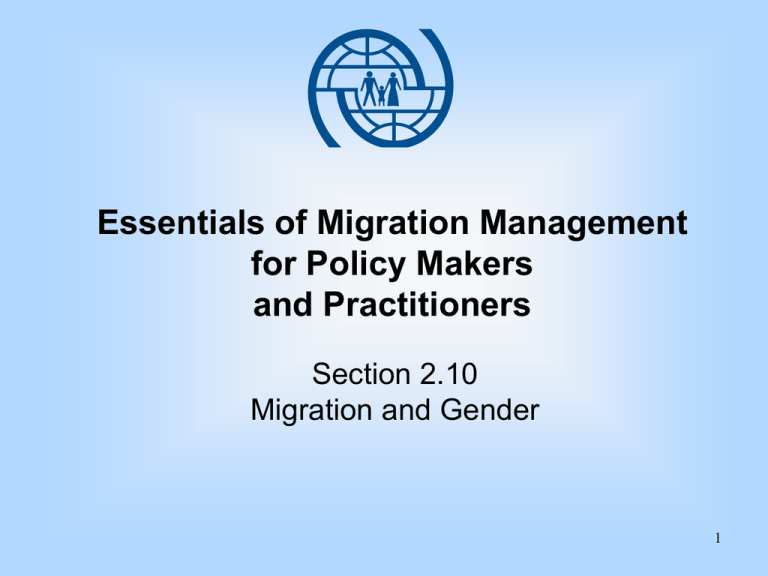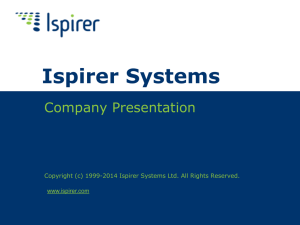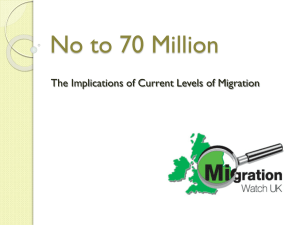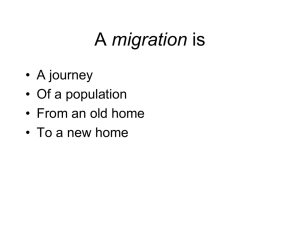
Essentials of Migration Management
for Policy Makers
and Practitioners
Section 2.10
Migration and Gender
1
Section 2.10 Migration and Gender
Learning Objectives
•
•
•
identify areas where gender is a significant factor in formulating migration
policy options
understand the importance of gender-related and gender-specific issues
develop your ability to assess the impact of gender on migration policy
options in your setting
2
Essentials of Migration Management
Section 2.10 Migration and Gender
Topic Titles
Topic One: Gender and Migration
Topic Two: The Legal Framework and the Global Agenda
Topic Three: Gender Issues and Migration Policy
3
Essentials of Migration Management
Section 2.10 Migration and Gender
Terms and Concepts
Gender
A term that refers to socially constructed differences between the sexes and to the
social relationships between women and men. These differences between the sexes
are shaped over the history of social relations and change over time and across
cultures.
Gender identity
An outcome of the circumstances in which women and men live, including
economic, cultural, historical, ideological, and religious factors
Gender relations
The relationship between women and men that varies according to the economic
and social conditions of the society and differs between social and ethnic groups
(Continued)
4
Essentials of Migration Management
Section 2.10 Migration and Gender
Terms and Concepts
International migrant
A person who lives outside his or her country of origin
Migrant
All cases where the decision to migrate is taken freely by the individual concerned,
for reasons of “personal convenience” and without intervention of an external
compelling factor
Migrant worker
A person who is to be engaged, is engaged, or has been engaged in a remunerated
activity in a State of which he or she is not a citizen
(Continued)
5
Essentials of Migration Management
Section 2.10 Migration and Gender
Terms and Concepts
Migration
A term used to describe the process of the movement of persons. It includes the
movement of refugees, displaced persons, uprooted people, as well as economic
migrants.
Sex
Biological differences between women and men
6
Essentials of Migration Management
Migration and Gender
Topic One
Gender and Migration
7
Topic One
Gender and Migration
Important Points
1.
The term “sex” refers to biological differences between women and men.
Biological differences are fixed and (mostly) unchangeable and vary little
across cultures and over time.
2.
Gender refers to differences between men and women and how they are
perceived in and by different cultures and social structures.
3.
The distinction between "gender" and "sex" can be significant.
4.
Gender is perhaps the single most important factor shaping migrants’
experiences—more important than their country of origin or destination, their
age, class, race or culture.
(Continued)
8
Essentials of Migration Management
Topic One
Gender and Migration
5.
Gender concepts useful in developing appropriate policy and programme responses:
•
Gender role - different activities that are ascribed to men and women based on their perceived
gender differences.
•
Gender gap - the disparity between demographic and actual representation regarding access to
rights, resources, and ability to be heard and counted.
•
Gender sensitivity - the recognition of differences and inequities between the roles,
responsibilities, needs, and identities of women and men.
•
Gender mainstreaming - methodology to work towards the advancement of women and gender
equality goals. The ultimate goal of gender mainstreaming is to achieve gender equality.
•
Gender equality - the norms, values, and rights required to ensure that men and women can
attain equal status without neutralizing the biological differences between them.
•
Gender equity - the process of fairness in granting access to resources (to be distinguished from
gender equality)
•
Gender balance refers to the participation of an equal number of females and males in an activity
or an organization, and more importantly, to an equal level of responsibilities for men and women.
•
Gender neutral - the pursuit of actions and interventions that are goal- or objective-based in a
manner that is free of gender impact.
•
Gender blind - actions that appear to be neutral but are in fact biased, and do not take into
account factors that contribute to a non-equitable outcome.
9
Essentials of Migration Management
Topic One
Gender and Migration
•
Gender-based analysis addresses the following points in a policy and
programme planning setting:
•
•
•
•
•
identification of the differences in the lives of men and women and if these
are addressed by the proposed policy and/or programmatic intervention
analysis of eventual diversities among different groups of women and men
involvement of men and women in the process in order to assess anticipated
and unforeseen impacts
identification of intended or unintended gender-specific or gender-related
impacts of a proposed policy
consideration of social, political, and economic realities external to the topic
addressed
10
Essentials of Migration Management
Topic One
Gender and Migration
Women and migration
•
In parallel with developments on the international scene, a number of
theoretical approaches have been initiated to examine issues related to
women, and subsequently to gender, that were gradually incorporated into
programmatic activities.
•
Research was initiated on these issues both from a developmental and
feminist perspective. The Women in Development (WID), Women and
Development (WAD), and Gender and Development (GAD) programmes
reflect three development-focused theories that were put forward
sequentially.
(Continued)
11
Essentials of Migration Management
Topic One
Gender and Migration
•
The first two theories evolved from simply following the approach “add
women, mix, and stir” without reflecting on societal roles and relationships
between men and women as well as on the impact of the variable of "power
relations" to an analysis that included a gender dimension.
•
On the other hand, in the Gender and Development theory, the analysis
starts by assuming that the behaviour, roles, and relations between men and
women are conditioned by societal structures and expectations, and
therefore have to be addressed as a totality and not in isolation.
•
Gender and Development theory attempts to put the position of men and
women on an equal footing and seeks to examine the impact of different
programmes and policies on both sexes.
•
The Women in Forced Migration Theory (WIFM) and Gender and Forced
Migration Theory (GAFM) were developed at later stages to address forced
migration situations, assess impact on women and gender, and apply this
approach to emergency programming.
12
Essentials of Migration Management
Migration and Gender
Topic Two
The Legal Framework and the Global Agenda
13
Topic Two
The Legal Framework and the Global Agenda
Important Points
1.
The notion of “gender” was introduced in the global agenda well after the
founding of the United Nations.
2.
An important development in the area of women’s rights was the adoption by
the General Assembly of the Declaration on the Elimination of
Discrimination against Women (GA Resolution 2263 (XXII) of 7/11/1967),
which provided support for further actions on issues related to gender (while
not having the force of a Treaty)
3.
The Convention on the Elimination of All Forms of Discrimination
against Women, (GA Resolution 34/180 of 18/12/1979), which enlarged the
provisions of the 1967 Declaration, was adopted by the General Assembly
and entered in force in September 1981.
(Continued)
14
Essentials of Migration Management
Topic Two
The Legal Framework and the Global Agenda
4.
The World Conference to Review and Appraise the Achievements of the
United Nations Decade for Women, in Nairobi in 1985, called for the sharing
of responsibilities between men and women, and for women to shift roles
from that of "recipients" of decisions taken by others to that of planners,
contributors, and decision makers.
5.
The Platform for Action adopted during the Fourth World Conference on
Women, in Beijing in 1995, advocated for equality between women and men,
not just elimination of obstacles to women’s status.
6.
The International Conference on Population and Development, in Cairo in
1994, and its consequent Programme of Action that included a set of
principles related to gender, demonstrate that gender-related considerations
do not operate in isolation but are interlinked and interrelate with a variety of
issues and policies including migration, population, economic growth and
development, education, and health.
(Continued)
15
Essentials of Migration Management
Topic Two
The Legal Framework and the Global Agenda
7.
The Millennium Declaration adopted in September 2000 reflects the progress
achieved throughout the decades in the direction of gender equality.
16
Essentials of Migration Management
Migration and Gender
Topic Three
Gender Issues and Migration Policy
17
Topic Three
Gender Issues and Migration Policy
Important Points
1.
In many societies, the social roles men and women play are different and are
valued differently, often along gender lines.
2.
Including a gender perspective in policy formulation and programme design
can contribute to them being gender-neutral rather than gender-blind.
3.
Policies in countries where migrants originate can impact on their ability to
migrate and affect men and women differently.
4.
Policies determine the migrant’s legal status, and whether he or she is the
“head of the household” or the “dependant.”
5.
In countries of destination, policies relating to admission, residence, access
to the labour market, and integration can affect migrants’ gender relations
because they influence the migration process for men and women differently.
18
Essentials of Migration Management
Topic Three
Gender Issues and Migration Policy
Questions relating to Gender when formulating Migration Policy Approaches
•
Do immigration policies in countries of destination influence migrants’ gender
relations? How do gender considerations in these countries have an impact
on migrants?
• Legal residence may be linked to a migrant woman’s relationship with a citizen or
principal migrant; if that relationship changes, she may face deportation or loss of
rights.
• Migrant women are particularly vulnerable in terms of reproductive health,
especially when access to health care is tied to the legal status of the migrant.
• Migrant men and women are likely to find themselves in a sexually segregated
labour market in the receiving country.
• While there are increasing possibilities for women to migrate autonomously, the
sectors of employment open to women are often limited.
• Many occupations place women in informal work situations with little access to
information networks and social support, leaving them vulnerable to discrimination
and abuse.
• Migrants bring with them a set of roles and relations that guide and determine their
behaviour.
19
Essentials of Migration Management
Topic Three
Gender Issues and Migration Policy
Questions that explore the Impact of Gender-related Factors on Migration
•
Do circumstances, culture and social structures as well as legal provisions in
countries of origin influence men’s and women’s ability to decide to migrate at
a given time? If so, how? Do they facilitate or impede the process?
•
The roles attributed to, and the relationships between, men and women in the
society of the country of origin not only define the productive and reproductive
roles attributed to men and women but also affect their ability to migrate.
•
The roles men and women have tended to assume in the social and economic
spheres have been highly differentiated.
•
In societies where women’s social status or employment prospects are poor,
women are often willing or eager to migrate, and can be more vulnerable to the
ploys of traffickers and to various forms of exploitation.
(Continued)
20
Essentials of Migration Management
Topic Three
Gender Issues and Migration Policy
•
Do relationships between men and women change with the migration
process?
•
There is no general rule on how roles and responsibilities are re-assigned as a
consequence of migration.
•
In some cases, little change occurs in the gender roles within the family. In others,
women take over male responsibilities at home, for example, by becoming main
providers or heads of households when men migrate.
Migration can have an empowering impact on women through the independence,
physical and financial, that they enjoy abroad, and the self-esteem gained by being
perceived as family providers by their community.
The reverse can also occur. Migrant women who have become the main family
providers may not be perceived as such by family members, including women
themselves, in these and other households.
Gender relations also determine the ultimate use of what migrants send home,
particularly their remittances, which are considered a part of the family income and
not their personal possession.
•
•
•
(Continued)
21
Essentials of Migration Management
Topic Three
Gender Issues and Migration Policy
•
Do relationships between men and women change during forced migration
situations?
•
Conflicts and disasters often lead to situations of forced displacement that affect
both men and women differently, and as a consequence, their needs for protection
and assistance are different.
•
Traditional gender roles have a tendency to change, or even to reverse, during
forced migration. This occurs particularly in regard to the power, or authority, to
make decisions.
22
Essentials of Migration Management
Last Slide
Section 2.10
Migration and Gender
23










